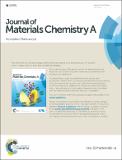Modification of the LSCM-GDC cathode to enhance performance for high temperature CO2 electrolysis via solid oxide electrolysis cells (SOECs)
Date
21/04/2017Grant ID
WRMA 2012/R2
EP/G01244X/1
EP/K015540/1
EP/D07259X/1
Metadata
Show full item recordAbstract
Extensive efforts have been made to find new fuel electrode materials for solid oxide cells with high activity and durability to provide more robust materials than the state-of-the-art material, the Ni-cermet . In the present study, a Ni-free cathode is presented with competitive performance and higher durability than a well-behaved Ni-YSZ cermet for CO2 electrolysis via SOEC. A (La, Sr)(Cr, Mn)O3/(Gd, Ce)O2 (LSCM/GDC) cathode fabricated by vacuum infiltration of GDC nitrate solutions into a LSCM/YSZ (8 mol% yttria stabilised zirconia) skeleton is reported. A porous YSZ layer introduced between the dense electrolyte and this cathode helps to maintain a good cathode/electrolyte interface, whilst the nano-structured GDC phase introduced on the surface of LSCM/YSZ backbone is advantageous to boost the cathode electrochemical and catalytic properties towards CO2 reduction by SOEC. Vacuum impregnation therefore offers an effective means to modify the microstructure of LSCM/GDC material set used as cathode for high temperature CO2 electrolysis. With the doping of Pd co-catalyst after GDC impregnation, the cathode activity of the GDC impregnated LSCM material is further enhanced for high temperature CO2 electrolysis, and the 0.5wt% Pd and GDC co-impregnated LSCM cathode achieves an Rp value of 0.24 Ω cm2 at OCV at 900oC in CO2-CO 70-30 mixture, a comparable level to a high performance Ni-YSZ cathode operated in the identical conditions.
Citation
Yue , X & Irvine , J 2017 , ' Modification of the LSCM-GDC cathode to enhance performance for high temperature CO 2 electrolysis via solid oxide electrolysis cells (SOECs) ' , Journal of Materials Chemistry A , vol. 5 , no. 15 , pp. 7081-7090 . https://doi.org/10.1039/C6TA09421J
Publication
Journal of Materials Chemistry A
Status
Peer reviewed
ISSN
2050-7488Type
Journal article
Description
This work was funded by Overseas Research Students Awards Scheme (ORSAS), University of St Andrews and by RCUK Energy Supergen programme on H-Delivery and EPSRC Platform and Senior fellowship programs (EP/G01244X/1). JTSI acknowledges the Wolfson Research Merit Award (WRMA 2012/R2).Collections
Items in the St Andrews Research Repository are protected by copyright, with all rights reserved, unless otherwise indicated.

